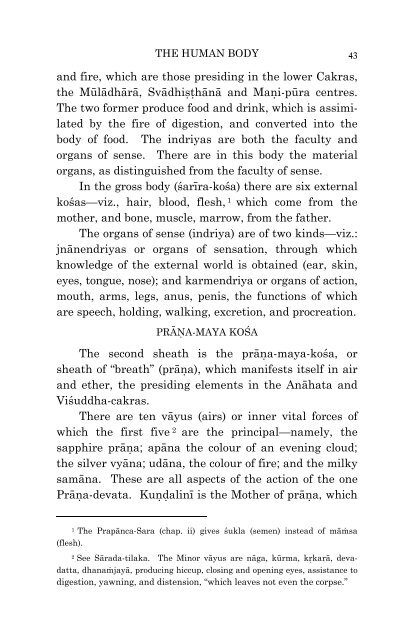Introduction to Tantra Sastra - Aghori
Introduction to Tantra Sastra - Aghori
Introduction to Tantra Sastra - Aghori
You also want an ePaper? Increase the reach of your titles
YUMPU automatically turns print PDFs into web optimized ePapers that Google loves.
THE HUMAN BODY 43<br />
and fire, which are those presiding in the lower Cakras,<br />
the Mūlādhārā, Svādhiṣṭ hānā and Maṇ i-pūra centres.<br />
The two former produce food and drink, which is assimilated<br />
by the fire of digestion, and converted in<strong>to</strong> the<br />
body of food. The indriyas are both the faculty and<br />
organs of sense. There are in this body the material<br />
organs, as distinguished from the faculty of sense.<br />
In the gross body (śarīra-kośa) there are six external<br />
kośas—viz., hair, blood, flesh, 1 which come from the<br />
mother, and bone, muscle, marrow, from the father.<br />
The organs of sense (indriya) are of two kinds—viz.:<br />
jnānendriyas or organs of sensation, through which<br />
knowledge of the external world is obtained (ear, skin,<br />
eyes, <strong>to</strong>ngue, nose); and karmendriya or organs of action,<br />
mouth, arms, legs, anus, penis, the functions of which<br />
are speech, holding, walking, excretion, and procreation.<br />
PRĀṆA-MAYA KOŚA<br />
The second sheath is the prāṇ a-maya-kośa, or<br />
sheath of “breath” (prāṇ a), which manifests itself in air<br />
and ether, the presiding elements in the Anāhata and<br />
Viśuddha-cakras.<br />
There are ten vāyus (airs) or inner vital forces of<br />
which the first five 2 are the principal—namely, the<br />
sapphire prāṇ a; apāna the colour of an evening cloud;<br />
the silver vyāna; udāna, the colour of fire; and the milky<br />
samāna. These are all aspects of the action of the one<br />
Prāṇ a-devata. Kuṇ ḍ alinī is the Mother of prāṇ a, which<br />
1 The Prapānca-Sara (chap. ii) gives śukla (semen) instead of māṃ<br />
sa<br />
(flesh).<br />
2 See Sārada-tilaka. The Minor vāyus are nāga, kūrma, kṛ karā, devadatta,<br />
dhanaṃ<br />
jayā, producing hiccup, closing and opening eyes, assistance <strong>to</strong><br />
digestion, yawning, and distension, “which leaves not even the corpse.”

















